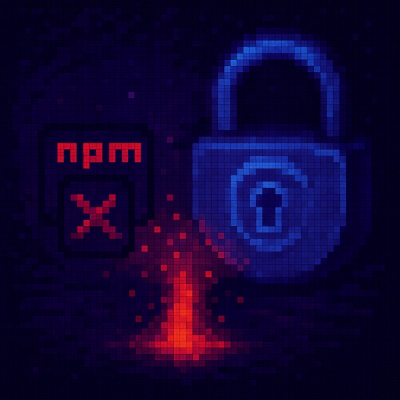
Security News
Software Engineering Daily Podcast: Feross on AI, Open Source, and Supply Chain Risk
Socket CEO Feross Aboukhadijeh joins Software Engineering Daily to discuss modern software supply chain attacks and rising AI-driven security risks.
@convex-dev/convex-react-query
Advanced tools
Instead of polling you subscribe to receive update from server-side query functions in a Convex deployment. Convex is a database with server-side (db-side? like stored procedures) functions that update reactively.
Instead of polling you subscribe to receive update from server-side query functions in a Convex deployment. Convex is a database with server-side (db-side? like stored procedures) functions that update reactively.
New results for all relevant subscriptions are pushed to the client where they
update at the same time so data is never stale and there's no need to call
queryClient.invalidateQueries().
See ./src/example.tsx for a real example. The general pattern:
queryKeyHashFn to convexQueryClient.hashFn() and queryFn to
convexQueryClient.queryFn(). Connect the ConvexQueryClient to the React
Query QueryClient.const convexClient = new ConvexReactClient(import.meta.env.VITE_CONVEX_URL);
const convexQueryClient = new ConvexQueryClient(convexClient);
const queryClient = new QueryClient({
defaultOptions: {
queries: {
queryKeyHashFn: convexQueryClient.hashFn(),
queryFn: convexQueryClient.queryFn(),
},
},
});
convexQueryClient.connect(queryClient);
useQuery() with the convexQuery options factory function called with
an api object imported from ../convex/_generated/server and the arguments
for this query function. These two form the query key.const { isPending, error, data } = useQuery({
...convexQuery(api.repos.get, { repo: "made/up" }),
gcTime: 10000, // unsubscribe after 10s of no use
});
staleTime is set to Infinity beacuse this data is never stale; it's
proactively updated whenever the query result updates on the server. (see
tkdodo's post
for more about this) If you like, customize the gcTime to the length of time a
query subscription should remain active after all useQuery() hooks using it
have unmounted.
fetchNew query results are pushed from the server, so a staleTime of Infinity
should be used.
Your app will remain subscribed to a query until the gcTime has elapsed. Tune
this for your app: it's usually a good tradeoff to use a value of at least a
couple seconds.
To run this example:
npm installnpm run devIf you wrap your app in a ConvexProvider you'll be able to use convex hooks
like useConvexMutation:
<ConvexProvider client={convex}>
<QueryClientProvider client={queryClient}>
<App />
</QueryClientProvider>
</ConvexProvider>
You can use this mutation function directly or wrap it in a TanStack Query
useMutation:
const mutationFn = useConvexMutation(api.board.createColumn);
const { mutate } = useMutation({ mutationFn });
TanStack Query isn't opionated about auth; an auth code might be a an element of a query key like any other. With Convex it's not necessary to add an additional key for an auth code; auth is an implicit argument to all Convex queries and these queries will be retried when authentication info changes.
Convex auth is typically done via JWT: some query functions will fail if
requested before calling convexReactClinet.setAuth() with a function that
provides the token.
Auth setup looks just like it's recommended in
Convex docs, which make use of components that
use native convex hooks. For Clerk, this might look like this: a ClerkProvider
for auth, a ConvexProviderWithClerk for the convex client, and a
QueryClient.
<ClerkProvider publishableKey="pk_test_...">
<ConvexProviderWithClerk client={convex} useAuth={useAuth}>
<QueryClientProvider client={queryClient}>
<App />
</QueryClientProvider>
</ConvexProviderWithClerk>
</ClerkProvider>
See the Convex Auth docs for setup instructions.
After cloning this repo run npm i to install dependencies. This package uses
tshy to publish an ESM. If there's ever demand
for a CJS build we can add "cjs" to the "dialects" section of "tshy" config in
the package.json.
To publish an alpha release, update the version in package.json to something
like 0.0.0-alpha.1 and run npm publish --tag alpha.
To publish a regular release, update the version in package.json to something
like 0.1.2 and run npm publish.
FAQs
Instead of polling you subscribe to receive update from server-side query functions in a Convex deployment. Convex is a database with server-side (db-side? like stored procedures) functions that update reactively.
The npm package @convex-dev/convex-react-query receives a total of 0 weekly downloads. As such, @convex-dev/convex-react-query popularity was classified as not popular.
We found that @convex-dev/convex-react-query demonstrated a not healthy version release cadence and project activity because the last version was released a year ago. It has 0 open source maintainers collaborating on the project.
Did you know?

Socket for GitHub automatically highlights issues in each pull request and monitors the health of all your open source dependencies. Discover the contents of your packages and block harmful activity before you install or update your dependencies.

Security News
Socket CEO Feross Aboukhadijeh joins Software Engineering Daily to discuss modern software supply chain attacks and rising AI-driven security risks.

Security News
GitHub has revoked npm classic tokens for publishing; maintainers must migrate, but OpenJS warns OIDC trusted publishing still has risky gaps for critical projects.

Security News
Rust’s crates.io team is advancing an RFC to add a Security tab that surfaces RustSec vulnerability and unsoundness advisories directly on crate pages.